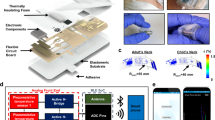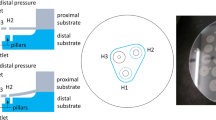Abstract
An implantable transducer for monitoring the flow of Cerebrospinal fluid (CSF) for the treatment of hydrocephalus has been developed which is based on measuring the heat dissipation of a local thermal source. The transducer uses passive telemetry at 13.56 MHz for power supply and read out of the measured flow rate. The in vitro performance of the transducer has been characterized using artificial Cerebrospinal Fluid (CSF) with increased protein concentration and artificial CSF with 10% fresh blood. After fresh blood was added to the artificial CSF a reduction of flow rate has been observed in case that the sensitive surface of the flow sensor is close to the sedimented erythrocytes. An increase of flow rate has been observed in case that the sensitive surface is in contact with the remaining plasma/artificial CSF mix above the sediment which can be explained by an asymmetric flow profile caused by the sedimentation of erythrocythes having increased viscosity compared to artificial CSF. After removal of blood from artificial CSF, no drift could be observed in the transducer measurement which could be associated to a deposition of proteins at the sensitive surface walls of the packaged flow transducer. The flow sensor specification requirement of +−10% for a flow range between 2 ml/h and 40 ml/h. could be confirmed at test conditions of 37°C.













Similar content being viewed by others
References
C. Baird, S. Farner, C. Mohr, T. Pittman, Pediatr. Neurosurg. 37(4), 186 (2002)
T.A. Balasubramaniam, H.F. Bowman, J. Biomech. Eng. 99, 148 (1977)
P.M. Black, R.G. Ojemann, A. Tzouras, Clin. Neurosurg. 32, 632 (1985)
I.G. Bloomfield, I.H. Johnston, L.E. Bilston, Pediatr. Neurosurg. 28(5), 246 (1998)
T. Bork, Thermal Flow Sensor Having Streamlined Packaging, US Patent No. 7,181,963 B2 (2007)
H.L. Brydon, G. Keir, E.J. Thompson, R. Bayston, R. Hayward, W. Harkness, J. Neurol. Neurosurg. Psychiatry 64, 643 (1998)
M. Critchley, J.L. O’Leary, B. Jennett, Scientific Foundations of Neurology, 1st edn. (Heinemann Medical, London, 1972)
H. Davson, M.B. Segal, Physiology of the CSF and Blood-brain Barriers, 1st edn. (CRC, New York, 1996)
A. Ginggen, Method for brazing two glass components, European Patent No. EP1184351 (2003)
A. Ginggen, Y. Tardy, R. Crivelli, T. Bork, P. Renaud, Biomedical Engineering, IEEE Trans. Biomed. Eng. 55(4), 1374 (2008)
International Standards Organization (ISO) 14708-1. Implants for surgery—Active implantable medical devices—Part 1: general requirements for safety, marking and for information to be provided by the manufacturer (2000)
W.H. Ko, A.M. Leung, E. Cheng, R.J. Lorig, Biotelem. Patient Monit. 8(3), 131 (1981)
V. Kurtcuoglu, M. Soellinger, P. Summers, K. Boomsma, D. Poulikakos, P. Boesiger, Y. Ventikos, J. Biomech. 40, 1235 (2007)
W. Kuschinsky, in Comprehensive Human Physiology, Vol. 1, ed. by R. Greger, U. Windhorst (Springer, Berlin, 1996), p. 545
T.S.J. Lammerink, N.R. Tas, M. Elwenspoek, J.H.J. Fluitman, Sens. Actuators, A 37–38, 45 (1993)
A. Larsson, C. Wikkelsö, M. Bilting, H. Stephensen, Acta Neurol. Scand. 84, 475 (1991)
A.A. Linninger, M. Xenos, D.C. Zhu, M.R. Somayaji, S. Kondapalli, R.D. Penn, IEEE Trans. Biomed. Eng. 54(2), 291 (2007)
F. Lundberg, D.Q. Li, D. Falkenback, T. Lea, P. Siesjö, S. Söderström, B.J. Kudryk, J.O. Tegenfeldt, S. Nomura, A. Ljungh, J. Neurosurg. 90, 101 (1999)
F. Mayer, A. Häberli, H. Jacobs, G. Ofner, O. Paul, H. Baltes, Proc. IEEE International Electron Device Meeting IEDM 97, IEEE 1997, p. 895-898. (1997)
F. Mayer, M.R. Hornung, R.S. Vanna, Flow sensor, US Patent No. 6813944 (2004)
I. Munshi, D. Lathrop, J.R. Madsen, D.M. Frim, Pediatr. Neurosurg. 28, 67 (1998)
W.R. Murshid, J.S. Jarallah, M.I. Dad, Pediatr. Neurosurg. 32, 119 (2000)
S. Neff, J. Neurosurg. Pediatr. 4 103(4 Supp.I), 366 (2005)
P.A. Neukomm, D. Furrer, Proceedings of the 17th Conference of the International Society on Biotelemetry ISOB 17, Brisbane 1 - 5 September (2003)
J. Oikonomou, A. Aschoff, B. Hashemi, S. Kunze, Eur. J. Pediatr. Surg. 9(Suppl. I), 23 (1999)
E.-K. Persson, S. Anderson, L.-M. Wikl, P. Uvebrant, Child’s Nerv. Syst. 23(10), 1111 (2007)
R.S. Rosenson, A. McCormick, E.F. Uretz, Clin. Chem. 42, 1189 (1996)
U. Schnakenberg, P. Walter, G. vom Bögel, C. Krüger, H.C. Lüdtke-Handjery, H.A. Richter, W. Specht, P. Ruokonen, W. Mokwa, Sens. Actuators, A 85(1–3), 287 (2000)
S. Sgouros, P. John, A.R. Walsh, Childs Nerv. Syst. 12, 454 (1996)
J.A.L. Vanneste, J. Neurol. 247, 5 (2000)
J. Vanneste, P. Augustijn, C. Dirven, W.F. Tan, Z.D. Goedhart, Neurology 42, 54 (1992)
J. Vassilouthis, J. Neurosurg. 61, 501 (1984)
S. Widell, Acta Paediatr. 47(suppl. 115), 1 (1958)
M. Wong, B.L. Schlaggar, R.S. Buller, G.A. Storch, M. Landt, Arch. Pediatr. Adolesc. Med. 154, 827 (2000)
Acknowledgements
This research was supported by the Swiss innovation promotion agency (grant CTI #8558.1 LSPP-LS). The authors would like to thank Dr. Roger Bayston for the recommendations concerning the test liquids and their preparation.
Author information
Authors and Affiliations
Corresponding author
Rights and permissions
About this article
Cite this article
Bork, T., Hogg, A., Lempen, M. et al. Development and in-vitro characterization of an implantable flow sensing transducer for hydrocephalus. Biomed Microdevices 12, 607–618 (2010). https://doi.org/10.1007/s10544-010-9413-6
Published:
Issue Date:
DOI: https://doi.org/10.1007/s10544-010-9413-6




